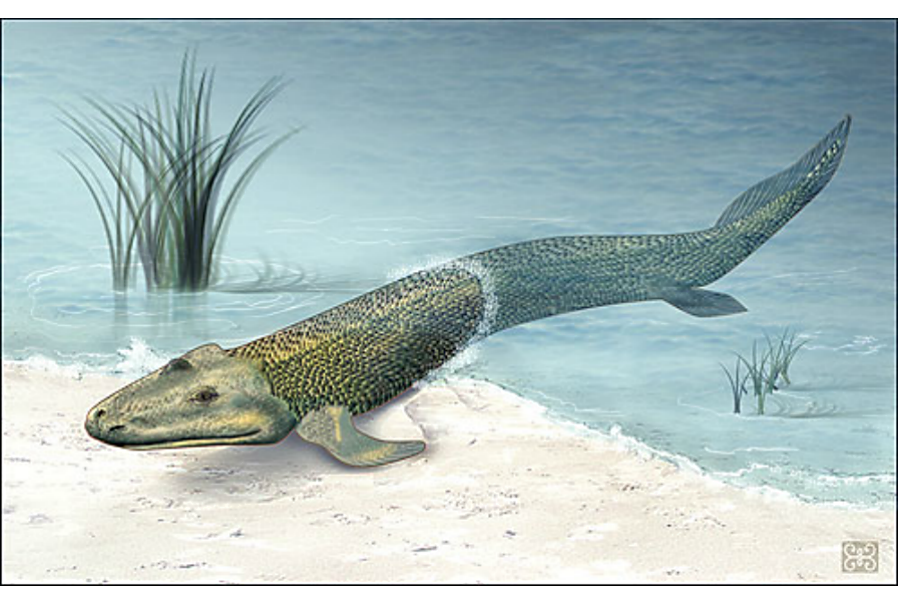Mysterious gap in the four-legged fossil record might not be a gap at all
A fish sprouts four limbs, wriggles onto dry land, begins to walk around, and then, BAM!, animals are living on land: It's a classic image of a key moment in evolution, oft repeated in comic strips.
But, as popular as that image is, scientists actually don't really know what that crucial evolutionary transition looked like. A 15-million-year gap in the tetrapod fossil record, called Romer's Gap, made that classic tale more of an estimation than something set in stone – until now.
An interdisciplinary team of paleontologists, geologists, and other specialists describe five new tetrapod species from fossils dating within just that gap, from about 360 million to 345 million years ago, in a paper published Monday in the journal Nature Ecology & Evolution. And these new fossils are already revealing insights into the deep evolutionary history of life on Earth.
Some vertebrates (animals with backbones) had already begun to sport four limbs that may have made them capable of moving onto land by the end of the Devonian, around 360 million years ago. But these animals were still mostly aquatic and had many other fish-like features. In the fossil record on the other side of Romer's Gap, the four-limbed animals had already become well-adapted to life on land, with long, five-digit-tipped limbs, and the ability to breathe air. And the life forms were quite diverse, suggesting that the early evolutionary radiation of these modern animals had already happened.
"That was the time during which these animals must have first become terrestrially capable and were used to walking on land," study lead author Jennifer Clack, a vertebrate paleontologist at Cambridge University in Britain, tells The Christian Science Monitor. "But we didn't know how they did it or when they did it or what adaptations they had to allow them to do this."
Michael Coates, the chair of the Committee on Evolutionary Biology at the University of Chicago, who was not part of the new research, describes it as "a bit of a blackbox. We know what comes in, we know what comes out, but we don't know what's going on within the blackbox," he says in a phone interview with the Monitor.
But now the picture is beginning to take shape.
The fossils that Dr. Clack and her colleagues describe sit right at the beginning of the gap, just a few million years after the end of the Devonian. Already, the tetrapods were diverse. In the new paper, the researchers describe five new species and at least seven other fossils that are too fragmentary to be categorized yet.
Of the five described, the researchers identify two of the species as early amphibians. The other three, they say, are more distantly related tetrapods. This would suggest that amphibians and amniotes (the group that eventually yielded mammals, birds, and reptiles) had already diverged by this time, making the evolutionary history of the two groups older than previously thought.
"This is a really useful contribution," Dr. Coates says of the new paper. "This is helping us to understand the structure of modern biodiversity."
It's not just the fossils themselves giving the researchers clues into the tetrapods' transition from water to land. By studying the rocks that encase the ancient animals' carcasses, geologists can glean clues about the environment in which the tetrapods lived.
"We have found tetrapod remains in different kinds of sediments representing different kinds of environments, but mostly they have been found in what have been called sandy siltstones," Clack says. The sandy siltstones, she explains, have been found on top of fossil soils that would have had plants growing out of them. "We think what happened is that the animals were living on this land surface and the sandy siltstones represent flood deposits that came and washed them away and preserved the bones."
The researchers think that this kind of consistently changing environment, with streams and rivers continually disappearing and forming in different locations, promoted evolution in these newly terrestrial animals. The tetrapods would have diversified as they had to adapt to this changeable environment.
It had been suggested previously that perhaps Romer's Gap was the result of low atmospheric oxygen levels at the end of the Devonian and beginning of the Carboniferous, which meant fewer and a lower diversity of tetrapods. But, along with the new fossil finds, the research team analyzed fossilized charcoal across the period and found that oxygen levels remained stable.
The researchers have also spotted more diversity across other groups of animals during the supposed gap, too. Taken together, this suggests "there almost certainly wasn't a gap in the fossil record at all," Clack says. "Or if there was, it's much shorter than people realize."
"It's a case of going to look in the right places, in the right kind of rocks," she says.
Understanding this period of time, called the Tournaisian, is important because when those four-legged, backboned animals evolved to live on land, they set the groundwork for the groups of animals that live today.
"We are descendants of the survivors from that time," Clack says. "All the flora and fauna of the Earth was changed during that period. And what survived is, largely speaking, what survives to this day: the foundation for modern floras and faunas."






